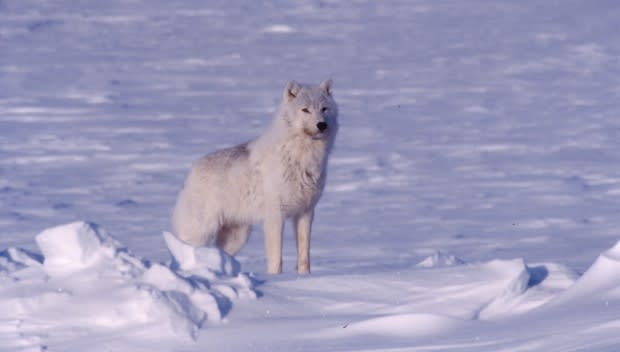Tlicho, N.W.T. governments submit joint wolf management plan to support caribou recovery
A joint management plan aimed at reducing the wolf population on the winter ranges of the dwindling Bluenose-East and Bathurst caribou herds includes increased incentives for hunters.
The five-year proposed plan, submitted by the Tlicho Government and the Government of the Northwest Territories Friday to the Wek'èezhìı Renewable Resources Board, aims to take pressure off the dwindling caribou herds by culling their fiercest predator — wolves.
The plan also calls for more training for harvesters, such as how to prepare pelts, as well as a goal to monitor wolves with tracking collars to learn more about them.
To make an effective dent in the population, the goal is to remove 60 to 80 per cent of the wolves from the Bluenose-East and Bathurst winter ranges.
"Wolf predation is one of the most important or major sources of caribou mortality throughout the year," said John Nishi, a biologist and consultant with the Tlicho Government.
A single wolf can eat between 23 and 29 caribou in a year, he said. The Bathurst caribou herd has seen a 98 per cent decline between 1986 and 2018. The Bluenose-East is also struggling.

The annual target for the proposed five-year wolf management plan is culling a combined 300 wolves each year: 100 from the Bathurst herd's range and 200 from the Bluenose-East herd's range.
Last year, hunters in the N.W.T. only culled 56 wolves as part of the incentive area.
Inuit hunters from western Nunavut, who are allowed to harvest wolves on the winter range, fared better and culled about 100 wolves.
Ninety-five per cent of the wolves culled the incentive area had eaten caribou, according to necropsies.
"We need to have other actions other than no harvest or restricted harvest. Our people are saying, 'What can we do, how can we help?'" said Tammy Steinwand-Deschambeault, director for the Tlicho government's department of culture and lands protection.

Under the new plan, all hunters in the incentive area, including Inuit hunters whose traditional territory includes the area, will get $1,200 per pelt through the Enhanced North Slave Wolf Harvest Incentive Program. For Inuit hunters, the Government of the Northwest Territories will pay $900 per pelt, with the Government of Nunavut paying another $300.
"We think we will see more wolves harvested this winter than last winter," said Bruno Croft, superintendent for the North Slave region for the N.W.T.'s Department of Environment and Natural Resources. He said the 2018-19 enhanced incentive program was launched late in the harvest season.
The plan includes surveying harvesters on how the harvest season went and what they saw on the land.
"It will depend on where the caribou are located, distribution of caribou, density of caribou and wolves. We have those targets in mind because we think it can be achieved. Let's see how it goes," he said.
If harvest targets aren't reached by the end of the harvest season, aerial harvesting — shooting wolves from a helicopter — will be considered.
Harvest and monitoring efforts will be reviewed every year once the plan has been approved, with a comprehensive review after five years.
The joint proposal is now before the board for review.


